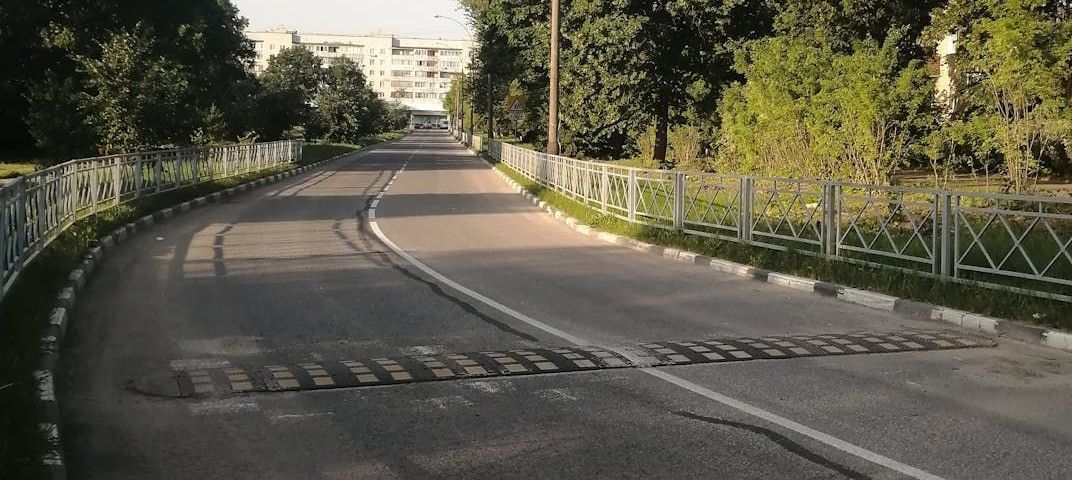Speed Bumps

Speed Hump
A speed hump is a raised area in the roadway pavement surface extending transversely across the travel way. Speed humps are sometimes referred to as “pavement undulations” or “sleeping policemen”.
Most agencies implement speed humps with a height of 3 to 3.5 inches (76 to 90 mm) and a travel length of 12 to 14 feet (3.7 to 4.3 m). Speed humps are generally used on residential local streets.
Speed Bump
Speed bumps are also a raised pavement area across a roadway. Speed bumps are typically found on private roadways and parking lots and do not tend to exhibit consistent design parameters from one installation to another. Speed bumps generally have a height of 3 to 6 inches (76 to 152 mm) with a travel length of 1 to 3 feet (0.3 to 1 m).
From an operational standpoint, speed humps and bumps have critically different impacts on vehicles. Within typical residential operational speed ranges, vehicles slow to about 20 mph (32 km/h) on streets with properly spaced speed humps.
A speed bump, on the other hand, causes significant driver discomfort at typical residential operational speed ranges and generally results in vehicles slowing to 5 mph or less at each bump.
Speed bumps of varying design have been routinely installed on private roadways and parking lots without the benefit of proper engineering study regarding their design and placement.
Speed humps, on the other hand, have evolved from extensive research and testing and have been designed to achieve a specific result on vehicle operations without imposing unreasonable or unacceptable safety risks.
Speed Table
Speed tables are essentially flat-topped speed humps, and may have a textured material on the flat section with asphalt or concrete for the approaches. Speed tables are sometimes referred to as “trapezoidal humps” or “speed platforms”. If marked as a pedestrian crossing, speed tables may also be referred to as “raised crosswalks” or “raised crossings”. Most agencies implement speed tables with a height of 3 to 3.5 inches (76 to 90 mm) and a travel length of 22 feet (6.7 m). Speed tables generally consist of 10 foot (3.1 m) plateau with 6 foot (1.8 m) approaches on either side that can be straight, parabolic or sinusoidal in profile. The longer lengths of speed tables provide a gentler ride than speed humps and generally result in vehicle operating speeds ranging from 25 to 30 mph (40 to 48 km/h) on streets depending on the spacing between speed tables. Speed tables are generally used on residential collectors, emergency routes or transit routes. The City of Portland, OR has designed “split” speed tables for designated emergency routes. Split speed tables are also 22 feet (6.7 m) long and extend from curb to centerline on opposite sides of the street. Split speed tables are separated by a longitudinal gap that allows fire trucks to weave around the split speed humps in slalom-like fashion. The Portland Department of Transportation is currently testing this alternative speed table design. Split speed tables are not included in this paper.
REFERENCES
AASHTO (American Association of State Highway and Transportation Officials). 2004. A Policy on Geometric Design of Highways and Streets, Fifth Edition. Washington, DC.
DeRobertis, M., Wachtel, A., 1996. Traffic Calming: Do’s and Dont’s to Encourage Bicycling, Presented at the Institute of Transportation Engineers Annual Meeting Compendium, Website accessed August 2006, http://www.ite.org/traffic/documents/AIA96E98.pdf 13
Ernish, E., Harrison, P., Yuvan, J. 1998. “Streets For People; Traffic Calming in your Neighborhood”, Neighborhood Streets Network, http://safety.fhwa.dot.gov/ped_bike/docs/streets4people.pdf Ewing, R., Traffic Calming: State of the Practice, Institute of Transportation Engineers, Washington, DC, Prepared for U.S. Department of Transportation, Federal Highway Association, Office of Safety Research and Development and Office of Human Environment, August 1999
Pedestrian and Bicycle Information Center (PBIC), Website accessed August 2006, http://www.walkinginfo.org/
Transportation Association of Canada (TAC). 1998. Canadian Guide to Neighbourhood Traffic Calming, Ottawa, ON, Canada.
Wainwright, W. S. 1998. Montgomery’s County Speed Hump Program: A Love-Hate Story, Presented at the Institute of Transportation Engineers 68th Annual Meeting, Held in Toronto, ON.
Zegeer, C. V. 1998. Committee Chair, ITE Traffic Engineering Council Committee TENC-5A-5, Design and Safety of Pedestrian Facilities, A Recommended Practice of the Institute of Transportation Engineers, Washington, DC.
Expert Commercial Pavement Maintenance: Asphalt Resurfacing, Milling, Sealcoating, Line Striping, and Patching Services.
BROWSE OUR WEBSITE
CONTACT INFORMATION
Location: 217 Luxor Rd. Latrobe Pa 15650
Phone: (724) 832-8451
Fax: (724) 832-8451
Email: brantsasphalt@comcast.net
OUR LOCATION
All Rights Reserved | Brant's Asphalt LLC | HIC# PA 000636 | Website Designed by Blue Crocus Solutions
